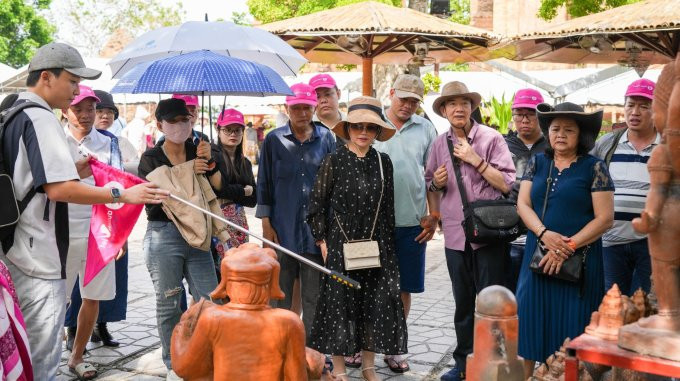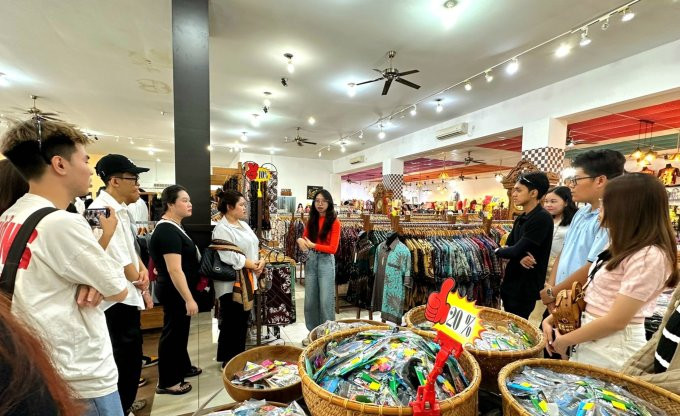Cheap shopping tours are easy for many tourists to access, but in return they take time and mainly visit free attractions.

According to a survey on travel choices with shopping with readers aged 18 and over who decide on the trip or participate in the destination selection process, 54% of respondents choose independent travel; 35% choose high-end tours without shopping and 11% accept shopping tours because they are cheap and they also like shopping.
Tran Huynh Nguyen, a lecturer and tour guide in Ho Chi Minh City with more than 20 years of experience, said that a shopping tour is a short name for a package tour sponsored by some shopping destinations abroad.
In many countries, local businesses that want to attract international visitors to their stores will use their marketing budgets to sponsor tour companies to offer discounted tours. In return, the tour companies will include local shopping destinations in their itineraries and take visitors there. According to many experts, this is a three-way win-win strategy: the store and tour company receive visitors, making more profit, and the visitors get to travel abroad at affordable prices. Visitors are not required to make a purchase when visiting these destinations.
Deputy General Director of Viet Travel Company Pham Anh Vu said that shopping during tours is "indispensable" and "accounts for the majority of every tourist's needs" to commemorate the trip. According to Mr. Vu's company's survey of customers, many said that shopping during a trip is "joyful".
From that demand of customers, travel companies have created tourism products combined with shopping during the discount season in destinations such as Singapore, Japan, Hong Kong. Many tourists when buying Thailand tours have researched the Pratunam wholesale market to visit and shop.
A representative of Viet Tourism said that there are currently no tours that only include shopping, except those designed specifically for customers. Instead, international tours will include sightseeing and shopping in their itineraries. These tours provide Vietnamese customers with the opportunity to travel abroad at low prices, meeting their needs to buy local products, and experience the culture and life of local people.
According to CENTours Director Tang Tat Hieu, the target customers of these shopping tours are people who travel less, are traveling abroad for the first time, or people who like to travel to many places to experience at affordable prices. "The advantage of this tour is that it is cheap, and you can visit many attractions in the host country, but mainly free of charge," said Mr. Hieu.
In addition to the advantages of cheap tours, experts also point out the disadvantages of this tour for tourists to consider when choosing. According to Mr. Huynh Nguyen, tour organizers are often complained by tourists when they do not have the need to shop but have to wait for others in the group to shop. The tour program does not skip shopping spots but requires them to visit. This tour often has the potential risk of conflicts between customers who like to shop and those who do not like to shop, making the trip that is meant to be relaxing and entertaining a trip of incidents and stress.
Mr. Anh Vu said that if there are too many shopping spots, it will reduce the time for sightseeing and traveling, making customers feel "tricked" or "forced to shop". "Some companies have put too many shopping spots in the tour schedule, making customers bored and even abandoning the tour halfway", Mr. Vu shared.
In addition, many shopping destinations have prices 30-50% higher than the market due to commission costs. Because of the low-cost tours, tourists often have to fly low-cost airlines, with bad flight times such as early morning or late afternoon. The itinerary visits many places, and the time at each place is short, so tourists often have to go from morning to late evening. Therefore, tourists on tours often have little time to rest, only have time to shower and go to bed at night, and do not have time to go out and observe the nightlife of the locals. Many tours, in order to reduce prices, give tourists 1-2 free days during the tour. During these days, tourists have to pay for their own food and drink, according to Mr. Hieu.

However, representatives of travel agencies all said that the shopping program is clearly stated in the itinerary sent to customers when they intend to buy the tour. Many agencies also note the amount of sponsorship that needs to be refunded if tourists do not visit the shopping spots according to the program.
Foreign package service providers always try to consider the harmonious arrangement of shopping and sightseeing spots to create a pleasant feeling for tourists. However, current tour prices in some familiar markets tend to stay the same such as Thailand, China, Japan, Taiwan, Korea while prices are increasing.
"Thus, the number of sponsored shopping points must also increase to maintain selling prices," said Mr. Nguyen.
Currently, international tours with shopping are popular with many tourists, including Thailand tours priced at 5-7 million VND for 5 days and 4 nights or China tours priced at 9-16 million VND for 4-6 days.
Mr. Tang Tat Hieu of CENTours encourages Vietnamese tourists who have traveled a lot, have experience, good foreign language skills and travel in small groups (less than 10 people) to travel independently. If tourists travel a lot but travel in large groups, they should buy a tour so that the unit can take care of all the organization, have a tour guide to support check-in at the airport, immigration, hotel check-in, call a car, and order food at restaurants.
For those with a low budget, new to traveling and who like to explore and experience, a tour with shopping is also a suggestion to try.
In addition, tourists can refer to non-shopping tours but with higher prices. Mr. Hieu said that currently, tours to Japan, Korea and Hong Kong are selling well, with prices ranging from 15 to 30 million VND and only do shopping tours when requested by customers. Instead, he focuses on experiential tours and only includes 1-2 shopping spots so that customers can buy souvenirs. These tours will be more selective due to the higher price, but in return, they will feel comfortable because they are traveling in the true sense.
"Going on a tour with shopping is often a form of self-torture. Going on a no-shopping tour is beneficial in terms of experience but hurts the wallet," commented Nguyen Ngoc Lan, a tourist living in Hanoi who has experience going on the above types of tours and traveling independently.
TH (according to VnExpress)